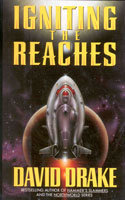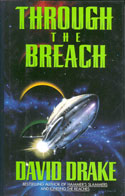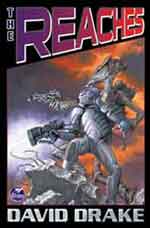INTRODUCTION: THE ONE THAT GOT AWAY
 I’m a very organized writer–insanely organized, one might say, and we’ll get back to that in a moment. I take extensive notes before I start plotting, and I do very detailed plots (usually in the range of 5-15,000 words per plot, though a few have been much longer).
I’m a very organized writer–insanely organized, one might say, and we’ll get back to that in a moment. I take extensive notes before I start plotting, and I do very detailed plots (usually in the range of 5-15,000 words per plot, though a few have been much longer).
Occasionally I hear a writer say something along the lines of, “My hero went off in a direction I didn’t expect.” I shake my head: my heroes don’t do anything of the sort. It turned out, however, that they could still surprise me.
 I got the notion of using the Age of Discovery as the background for a series of space operas. I’d bought a set (eight volumes) of Hakluyt’s Voyages (the 1598 edition, which adds a great deal of material but drops David Ingram’s very interesting account from the 1589 edition) while I was still an undergraduate and dipped into it frequently. When I chose that world for my setting, I read and took notes of the whole work. I then started plotting.
I got the notion of using the Age of Discovery as the background for a series of space operas. I’d bought a set (eight volumes) of Hakluyt’s Voyages (the 1598 edition, which adds a great deal of material but drops David Ingram’s very interesting account from the 1589 edition) while I was still an undergraduate and dipped into it frequently. When I chose that world for my setting, I read and took notes of the whole work. I then started plotting.
The life of Francis, later Sir Francis, Drake lent itself to development into a trilogy: his first voyages to the Caribbean, which made him an enemy of Spain and gained him a name; the round the world voyage of 1580-1, which brought him great wealth and a knighthood; and finally the climactic struggle against the Armada. I actually followed Drake’s life quite closely, but especially in the second book I wove in events which happened to some of his contemporaries.
 Though Drake was my model, I didn’t attempt to tell the stories from his viewpoint. He’s a very attractive man in many ways. His luck was in great measure the result of careful planning. For example, he didn’t lose a man to scurvy, the deficiency disease which nearly wiped out Magellan’s crew during the only round the world voyage preceding Drake’s. Anson, a century and a half later, was still losing large numbers of crewmen to scurvy. Drake had figured out something that the greatest navigators before and after him did not, to their great cost.
Though Drake was my model, I didn’t attempt to tell the stories from his viewpoint. He’s a very attractive man in many ways. His luck was in great measure the result of careful planning. For example, he didn’t lose a man to scurvy, the deficiency disease which nearly wiped out Magellan’s crew during the only round the world voyage preceding Drake’s. Anson, a century and a half later, was still losing large numbers of crewmen to scurvy. Drake had figured out something that the greatest navigators before and after him did not, to their great cost.
Furthermore, in a cruel age and under brutal conditions, Drake wasn’t himself cruel and didn’t allow those under him to practice cruelty. This is truly remarkable, more remarkable than readers who haven’t been in hard places themselves can imagine. Drake, suffering a painful wound from an Indian ambush, prevented his men from bombarding the Indian village. He said, probably correctly, that the Indians mistook him for a Spaniard–but the man who could do that after an arrow has been pulled from his face was humane in the best sense of the word.
But.
Drake was a religious fanatic and a fanatical patriot. He had sufficient reason–Philip II of Spain was a tyrant from the same mold as later provided the world with Hitler–and Drake’s behavior was almost invariably within what now are accepted civilized norms. (The one instance of a war crime in modern terms involved hanging a hostage priest and promising to hang more if the Spaniard who’d murdered an envoy under a white flag weren’t surrendered for punishment.)
But if what Drake did is acceptable, what he was is not. I don’t say that I couldn’t get into the mind of a fanatic, but the world and my world wouldn’t be better places if I did so. I told the story–the stories–from the point of view of fictional sidekicks who, though men of their times, took a detached attitude toward the great issues of their day. Men, in short, who weren’t very different from me.
I won’t say that was a mistake, but I think it is the reason that the wheels came off my careful plan. Those viewpoint characters turned out to have minds of their own: my mind. And as a result, the novels weren’t at all what I’d intended them to be.
That’s the background to The Reaches. I’ll now offer three… well, call them caveats regarding the books themselves.
- I postulated a future in which war had brought Mankind to the brink of extinction. The civilization that returns is based on individual craftsmanship, not mass production (although that’s clearly on its way back by the end of the series). Some readers, faced with stories in which the characters fly starships but fight (some of them) with single-shot rifles, were not only baffled but infuriated.
- Though I didn’t use ideologues for my viewpoint characters, the period itself was fiercely ideological. I didn’t attempt to hide that reality by inventing characters with modern sensibilities to exclaim with horror at situations which everyone of the day took for granted. Thus the books are deeply steeped in ideology that readers may find not only foreign but distasteful.

- Finally, I’d intended The Reaches to be light space opera, the sort of thing I later did in the RCN series. Space opera they are, but they’re very hard, harsh books. Through the Breach in particular is a more realistic view of what war does to a citizen/soldier than Redliners was. I’m more self-aware now than I was when I wrote the series, but I’m honestly not sure whether more than chance was involved in my choosing to write Through the Breach in first person, which is nearly unique in my fiction.
There’s no single Truth in my world, but there are lots of little truths. There are several of those woven into The Reaches, but they’re not all of them the truths that make me happiest in the hours before dawn.
—Dave Drake
Igniting the Reaches. 1994, New York, NY: Ace Books. 262 p.0441000266 (hc). $18.95.
————– 1995, New York, NY: Ace Books. 262 p. 0441001793 (pb). $4.99.
Through the Breach. 1995, New York, NY: Ace Books. 327 p. 0441001718(hc). $19.95.
————– 1996, New York, NY: Ace Books. 327 p. 0441003265 (pb). $5.99.
Fireships. 1996, New York, NY: Ace Books. 326 p. 044100329X (hc). $19.95.
————– 1997, New York, NY: Ace Books. 326 p. 0441004172 (pb). $5.99.
All reprinted in The Reaches. 2004, Riverdale, NY: Baen. 874 p. 0743471776 (hc) $24.00